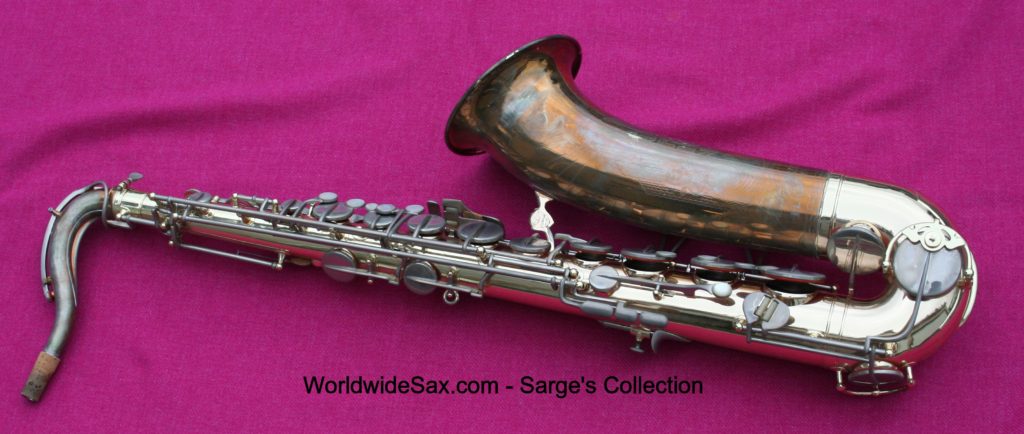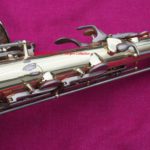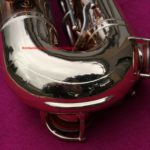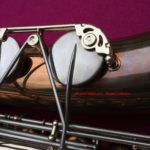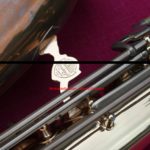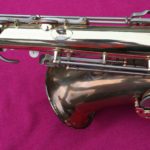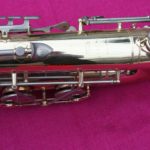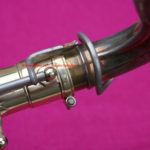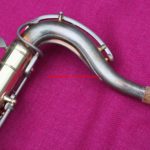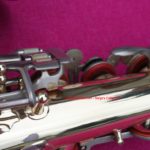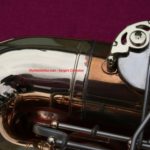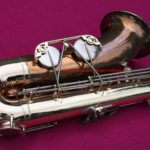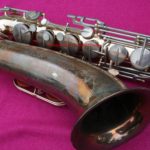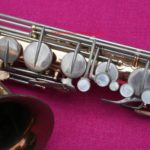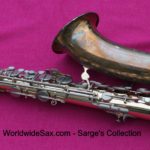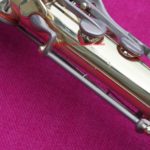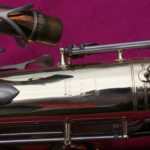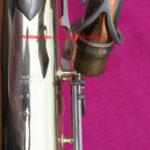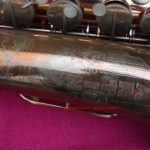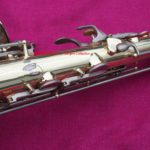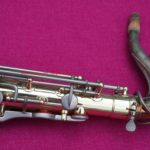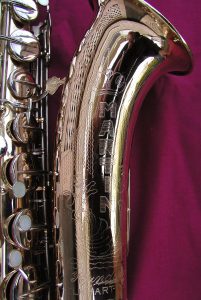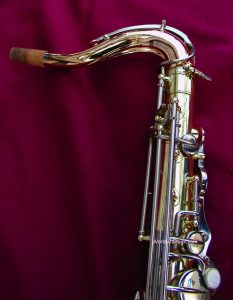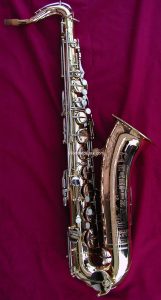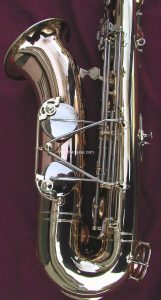1939 Martin Committee 2 "Lion & Crown" Tenor
From Sarge's Collection
(For large photos, "right-click" and "open in new tab")
Price: SOLD
Tarnished Photos(2018):
Sarge's "Before" Photos (older than 2008):
***Chadd comments: Note how the neck and body appear more pink in the "before" photos under the lacquer.. Perhaps the body tube is still lacquered brass?!
- Year: 1939
- Make: Martin
- Model: Committee 2 "Lion & Crown"
- Status: SOLD
- Finish: Rose Gold plated; Lacquer; Nickel keys
- Serial Number: 133,585
From Sarge's Collection - the rarest of the rare...
Here's how I (chadd) can tell the story Sarge told me:
Sarge bought this sax in connection with the story that "it was custom built for a top salesman at the Martin Company." It has a rose gold plating. It was originally fully covered with the lacquer and Sarge thought it was silver... So he stripped the lacquer to find out the surprise - What you see is the bell and neck without lacquer. The rose gold, due to having a copper blend, will tarnish much faster than silver or gold. It becomes that brownish-pink color.
Also, during the last 10 years (2008-2018), I can say that we have only played this sax about 4-5 times. Otherwise it was left out of reach.
Sarge's own words:
"Now here is the story and it's a good one... I just bought this one, from the 2nd owner. it was obviously in top condition, but was advertised as in original silver plate and then later shot with clear lacquer over everything. I have seen that done and if it's done well, with a thin overcoat, it can be pretty great, so i paid a pretty good price for it and was happy to do so, as these are easily the most beautiful sounding tenor ever made... the ultimate Ballad horn.
Soooo, i had it and had been playing it about a week and loved it... but i can't help being a compulsive restorer.. so on one of my days off, i chem-stripped the bell and neck of the overcoat... and Lo and Behold, it isn't silver at all... but Rose Gold Plate. Ultra rare on Martin saxes. Sooo, i had to know more about the original owner, because a horn like this would only have been made for someone the Martin Company considered very special. The second owner got back to me, with this story. He knew the original owner since he was a child... the man played in a band with his dad. 2nd owner always loved the 1st owners horn and asked frequently if he could ever buy it to play himself. Long story short, 1st owner passed on, left word with daughter that 2nd owner was to be offered the sax before anyone else. Turns out 1st owner was a musician and a "Rep" for Martin, his entire career, so Martin made this sax as a one of one a kind for him.
Well, it's found a new home and a 3rd owner who really appreciates vintage treasures... so it's going to stay with me until i pass on. Here are some pics of this beauty, before and after the chem strip."
FINISH: Some added specifics that will help expand on what you see:
-The bell and neck have had the lacquer stripped off. Otherwise the rose gold underneath is a vibrant yellow (!); almost like a soft Yamaha color. ***However, note how the neck and body appear more pink in the "before" photos under the lacquer. Perhaps the body tube is not rose gold...!?
-I intend to polish he tarnish off and feature a few photos also (To be added...)
-The nickel keys appear to have tarnished as a reaction to some 'shop air'. I noticed that I could wipe off the cloudy look with care.
-I can't explain the ring on the thumb hook or marks at the neckstrap ring.
-(While original lacquer Committee II's had lacquer over their nickel keys, I can't say anything specific about the keys on this sax to see any change in their finish).
-***Sarge's Curiosity Proof, Part 2: Sarge was a detailed worker and an excellent technician. I still find it odd to this day that he didn't create a very clean line on the bell for the stripping solution (See: Photo 007-tube, 003-engraving). I think this further supports his curious spirit of disbelief that it was something special underneath the ["it looks like a relacquer"-shine] of bright yellow.
GENERAL INFO:
-Serial #133,585 on neck and body match.
-Pings and dings? = limited! I photoed a few; an odd, tiny ding by the palm keys...
-PADS: They are an orange hue, partly reddish, with plastic resos. I am completely guessing here, but I think Sarge acquired this sax in the 1980s or 90s. (It could have been in the 2000s). He NEVER mentioned that he did the repair work on this sax; only that he stripped the lacquer on the two zones.
CASE: We have an original Martin Committee II case. (Chadd: I can't say that it was the original case, because the sax's condition far surpasses the case's.)
Committee II's are great ballad kings. They have a more focused bell that the Committee III (The Martin) and you'll love the comfortable thumbrest (octave rest). Nickel keys/rods, and lacquer cups and body.
Will you be the 4th owner of this amazing sax?
Sound File on a Committee 2 for you to enjoy:
- 1.Tenors file: Selmer MKVI vs. Martin Comm 2 vs. Martin Comm 31:37
Item #:SSP01201.8-98

